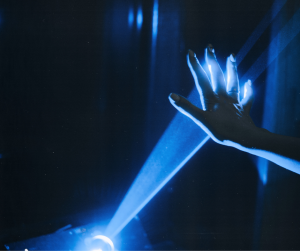Spirit tech refers to brain-based technologies used to guide spiritual enhancement. The future of spirituality is here and growing. Empowered by knowledge, we can help shape how communities will embrace and apply these technologies.
Neurofeedback-guided meditation

Meditation techniques have been around for thousands of years and can be incredibly potent as an adjunct to human life for some people. Traditional meditation might only be really effective for a few people, with special brains, but the tech-enhanced forms of meditation training can have a big impact on a lot of different kinds of people.
Spiritual technology democratizes meditation.
Brain-based interventions used with meditation training (quantitative EEG-guided neurofeedback, ultrasound/magnetic/electric-guided brain stimulation, psychedelic entheogens, etc.) are therefore likely to have a big impact on all kinds of people’s lives in years to come.
The point of several of the most prominent forms of spirit tech (like the Muse brain-sensing neurofeedback headband and the Zendo electric stimulation meditation system) is to tackle this challenge by providing the brain with either feedback or actual “nudges” (via gentle stimulation) to coax or boost the brain into the desired state. These can “gamify” the experience by giving the user goals and helping track progress, which is almost impossible with traditional methods. They help the brain understand what it feels like to enter the desired meditative state and help build the neural pathways so the user can eventually do it comfortably on their own – and perhaps even go deeper than where the technology is designed to get you.
Human togetherness in virtual reality
Virtual reality groups allow people to gather in virtual space to hold spiritual rituals. There are all sorts of groups – traditional religious groups, but also less traditional spiritual practices. The VR technology can effectively “trick” the brain into experiencing a sense of presence with others and can facilitate forms of connection that are even hard to come by in person. VR contact may not always be preferable or as valuable as being together in person, but it does hold fascinating potential.
David Glowacki’s project Isness is a multi-person VR “journey,” which represents the participants to each other as colorful, glowing “energetic essences” rather than traditional avatars. The goal of Isness is to induce “mystical-type” experiences for each person, while as a group, they “experience the collective emergence, fluctuation, and dissipation of their bodies as energetic essences.”
Even though the people in the physical space are wearing VR headsets, each headset is equipped with access to positioning data so they can see and interact with a VR representation of the other participants’ energy fields. Participants also wear “mudra gloves” equipped with a tracking device, allowing participants to see, reach out, and touch hands with others during the experience. And if participants put their hands in a specific “mudra pose,” touching their thumb to either their forefinger or middle finger, their hands begin emitting light in the virtual space.
By manipulating a set of “aesthetic hyperparameters,” the facilitators of Isness are able to construct a journey for the participants through 13 different phenomenological states modeled after concepts emerging from research on psychedelic drug effects including matter as energy, connectedness, unity, ego dissolution, transcendence of space and time, and noetic quality.
Brain-stimulation in spiritual rituals
Neuroscientist Jay Sanguinetti and world-renowned meditation teacher Shinzen Young are working together at the Sonicare Enhanced Mindful Awareness lab in Arizona researching ultrasound to stimulate meditative states. They created a prototype meant to be a “technoboost” for meditation that led to one of Shinzen’s most profound meditation experiences (after decades of meditation).
Because ultrasound can be focused, it can penetrate far more deeply into the brain than other stimulation technologies. It can reach all the way to parts of the brain that magnetic and electrical stimulation can’t, making it promising for producing intense spiritual experiences. But nobody really knows precisely how it works at this point, and there’s no question that it has to be done carefully.
Mikey Siegel, an MIT-trained roboticist who is a thought leader in the spirit tech space, has created a set of technologies he uses to create religious rituals called Group Flow. The point of Group Flow is to facilitate group consciousness, communal spiritual connection, and interpersonal intimacy. Siegel calls it “a kind of permissioning tool” that gives people a pathway or means to open up more and to become less defended, so that they can be more real and vulnerable with themselves and with one another.
In essence, it’s a ritualized spiritual gathering that involves electrodes, wires, flashing lights, and electronic sounds – all with the goal of enhancing deeply honest, transformative, lifegiving spiritual connection among participants. In terms of what it actually is, Group Flow harnesses sound and light in a few key components, creating a set of technologies that can be used in slightly different ways to facilitate different types of connection.
Incorporating entheogens
Entheogens are non-addictive plants and chemicals with psychedelic properties. Using psychedelics, such as psilocybin or DMT, is not a technological advancement in facilitating spiritual experiences, but one that is being used in hand with other enhancements.
Psilocybin is an incredibly important kind of fungus and is being tested in all kinds of studies, especially at Johns Hopkins University. Psychedelic mushrooms can be life-changing for helping people cope with death anxiety, addiction, and a bunch of other intractable medical and mental health challenges.
DMT is one of the few psychedelic compounds that is naturally produced in the human brain. It can produce existentially potent experiences and religious traditions that centralize DMT in their rituals consider these induced experiences sacred. DMT is one of the key components of ayahuasca, which combines DMT and MAOIs. Ayahuasca, especially when ingested in ritual settings, appears to have incredible healing potential.
There are three main routes that people engage with ayahuasca. First, there are two Christian denominations that are approved in the US to take ayahuasca as their sacrament – Santo Daime and Uniao do Vegetal (UDV). Second, some choose to engage in shamanic ritual settings in places like Peru. This is a huge industry with all sorts of retreat centers available for tourists from other parts of the world – some are more reputable than others. Third, scientists have tried to create artificial versions of ayahuasca brews, called pharmahuasca, which combine DMT and MAOIs in precise combinations, free of the “impurities” that are inevitably involved in ayahuasca brews. The reason people choose this third route is often because of the ability to control dosage and know precisely what they’re ingesting. But ayahuasca shamans treat the brews, with all of their chemical complexity, as an important part of the ritual.
This post is adapted from an Ask Me Anything event on Reddit. View the original posting here.



